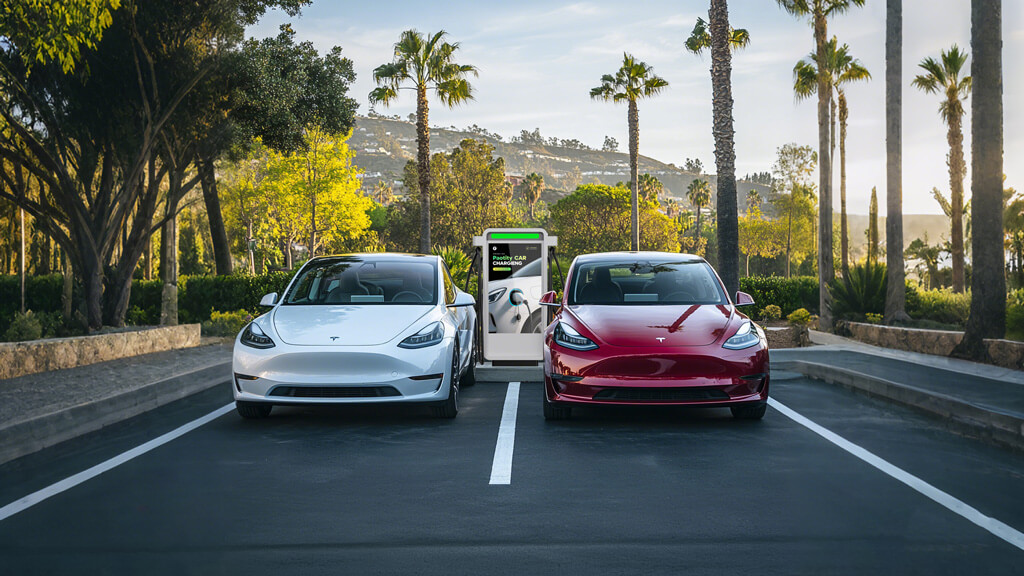What is Electric Vehicle Supply Equipment (EVSE)?
Under the wave of global transportation electrification and green energy transition, EV charging equipment (EVSE, Electric Vehicle Supply Equipment) has become the core infrastructure to promote sustainable transportation, EVSE is not just a charging post, but an integrated system with multiple functions such as power conversion, safety protection, intelligent control, data communication and so on, EVSE is not just a “charging post”, but a comprehensive system that integrates power conversion, safety protection, intelligent control, data communication and other multiple functions. It provides safe, efficient and intelligent energy interaction between electric vehicles and the power grid, and is a key node of the intelligent transportation network.
According to the International Energy Agency (IEA) 2024 report, the annual growth rate of EVSE deployment in Europe and the United States is more than 30%, and intelligence and interconnectivity have become the mainstream trend in the industry. Data from the U.S. Department of Energy shows that the number of public charging stations in North America has exceeded 150,000, and major European countries are also accelerating the layout of smart infrastructure.
The core components of electric vehicle power supply equipment
The structural design of EVSE directly determines its safety, reliability and intelligence level. The main components include:
1. shell
Shell is the EVSE “shield”, usually made of high-strength corrosion-resistant materials (such as stainless steel, aluminum alloy, engineering plastics), with waterproof, dustproof, impact resistance and other characteristics. High protection level (e.g. IP54/IP65) ensures the equipment to operate stably for a long time in outdoor and extreme environment.
2. Main Board Circuit
The main board circuit is the “nerve center” of EVSE, responsible for power conversion, signal processing, and charging control. It integrates the power module, measurement module, safety protection circuits (e.g. over-current, over-voltage, and short-circuit protection), and communication module to ensure that the charging process is efficient and safe.
3. Firmware
Firmware is the “operating system” of EVSE, which is embedded in the motherboard and is responsible for the logical control of the device, the implementation of charging protocols, status monitoring and remote upgrading. The high-quality firmware supports various international standards (e.g. OCPP, ISO 15118), which facilitates the subsequent expansion of functions and intelligent upgrading.
4. Ports and Cables
Ports and cables are the “bridge” between EVSE, EVs and the power grid. High-quality ports and cables need to be highly conductive, high-temperature-resistant, wear-resistant, etc., to ensure the safe transmission of large currents over long periods of time. Some high-end EVSEs are also equipped with automatic cable retractors to enhance user experience and equipment life.
Comparison Table: Hardware vs. Software Main Functions
| Dimension | Hardware (EVSE Device) | Software (Management & Service Platform) |
|---|---|---|
| Main Role | Provide safe and efficient power output | Enable remote management, data analytics, and intelligent scheduling |
| Typical Features | Charging module, protection module, V2G interface | Device management, energy management, payment, data analytics |
| Technical Trends | High power, modularization, enhanced protection | Cloud platform, big data, AI, open protocols |
| Business Value | Device reliability, compatibility, scalability | Cost reduction and efficiency, business model innovation, improved user experience |
Network connectivity: the foundation of intelligence
Modern EVSE generally has the ability of network connection, through Ethernet, Wi-Fi, 4G/5G and other means of real-time data interaction with the cloud platform and management system. Network connectivity allows EVSE to have remote monitoring, fault diagnosis, equipment upgrades, intelligent scheduling and other functions. Networked EVSE not only improves O&M efficiency, but also provides the technical foundation for data-driven business models (e.g. dynamic pricing, energy consumption analysis, user behavior analysis).
Charger type: diversification to meet different needs
EVSE is categorized into various types according to output current, charging speed and application scenarios:
| Type | Main Features | Typical Application Scenarios |
|---|---|---|
| AC Charger | Outputs 220V/380V AC, power ≤22kW | Home, Office Buildings, Shopping Malls |
| DC Fast Charger | Outputs DC, power up to 350kW or above | Highways, Urban Fast Charging Stations |
| Wireless Charger | Uses electromagnetic induction, no need to plug or unplug cables | High-end Residences, Future Parking Lots |
AC charging: suitable for long time parking, slow charging, low equipment cost, suitable for home and office.
DC fast charging: suitable for fast charging demand places, fast charging speed, suitable for public and urban hubs.
Wireless charging: emerging technology, enhancing user convenience, high potential for future development.
Comparison table: AC vs. DC chargers
| Item | AC Charger | DC Fast Charger |
|---|---|---|
| Output Current | AC | DC |
| Power Range | 3.5-22kW | 30-350kW |
| Charging Speed | Slow | Fast |
| Application Scenarios | Home, Office Buildings, Shopping Malls | Public Fast Charging, Highways |
| Installation Cost | Low | High |
| Smart Features | Basic Smart Functions Supported | Advanced Smart and Remote Management Supported |
Ports and Cables: The Guarantee of Safety and Compatibility
Within Electric Vehicle Supply Equipment (EVSE) systems, ports and cables are not just conduits for electrical energy—they are critical components that ensure both the safety of the charging process and the compatibility of the equipment. Different countries and regions adopt various port standards, with common types including Type 1 (SAE J1772, primarily used in North America), Type 2 (IEC 62196, widely adopted in Europe), and GB/T (the national standard in China). Selecting the appropriate port standard allows EVSE to be compatible with a wide range of vehicle models, thereby enhancing user experience and expanding market reach.
High-quality charging cables must possess several key performance features.
Firstly, heat resistance ensures that the cable can withstand prolonged high-current operation without degrading or becoming damaged.
Secondly, excellent flexibility and bend resistance allow the cable to remain durable and reliable even after repeated use and coiling.
Additionally, water and dust resistance are essential for coping with harsh outdoor environments, significantly extending the service life of the equipment. Some advanced EVSE products are equipped with intelligent recognition technology, which can automatically identify the type of connected vehicle and adjust charging parameters accordingly.
At the same time, automatic locking functions help prevent accidental or malicious unplugging, greatly improving charging safety and anti-theft capability. Choosing ports and cables that are safe, highly compatible, and intelligent is fundamental to building an efficient and reliable charging network.
Connector types: global standards and trends
The connector is the direct physical interface between the EVSE and the electric vehicle. The main types are:
Type 1 (SAE J1772): mainstream in North America, for single-phase AC charging.
Type 2 (IEC 62196): Mainstream in Europe, supporting single-phase and three-phase AC.
CCS (Combined Charging System): compatible with AC and DC fast charging, mainstream in Europe and the United States.
CHAdeMO: Japan mainstream, designed for DC fast charging.
GB/T: China's national standard, covering both AC and DC charging.
The global trend is toward multi-standard compatibility and high power fast charging. Choosing a compatible EVSE helps to improve market coverage and user experience.
Comparison table: Mainstream connector standards
| Standard | Applicable Region | Supported Current Type | Power Range | Compatible Vehicle Types |
|---|---|---|---|---|
| Type 1 | North America | AC | ≤19.2kW | American, Some Japanese |
| Type 2 | Europe | AC | ≤43kW | European, Some Chinese |
| CCS | Europe & North America | AC/DC | ≤350kW | Multiple Brands |
| CHAdeMO | Japan, Some Europe & NA | DC | ≤62.5kW | Japanese, Some European |
| GB/T | China | AC/DC | ≤250kW | Chinese |
Common Features of Chargers: Intelligence, Data-Driven Operation, and Business Enablement
Modern EVSEs are not just "power supply tools" but intelligent terminals. Their core features typically include:
•Smart Billing: Supports various billing methods (by time, by energy consumed, dynamic pricing), facilitating commercial operations.
•Remote Monitoring: Real-time monitoring of device status, with support for remote fault diagnosis and maintenance.
•Scheduled Charging: Users can reserve charging time slots via apps or platforms, improving resource utilization.
•Load Management: Automatically adjusts charging power based on grid load to avoid peak demand stress.
•Data Collection and Analysis: Records charging data, supports energy consumption statistics, carbon emission monitoring, and user behavior analysis.
•Remote Firmware Upgrades: Delivers new features and security patches over the network to keep devices up to date.
•Multi-User Management: Supports multiple accounts and permission hierarchies, making centralized management easier for clients.
•Value-Added Service Interfaces: Such as advertising delivery, membership management, and energy optimization.
Future Trends
V2G (Vehicle-to-Grid Interaction): Electric vehicles can reverse power the grid, realizing a two-way flow of energy.
Wireless charging: Enhances convenience and is suitable for high-end residential and future autonomous driving scenarios.
Automatic Parking Charging: Combined with autonomous driving, realize unmanned charging experience.
Green Energy Integration: Deeply integrate with renewable energy sources such as solar and wind energy to promote low-carbon transportation.
FAQ
1.What is Electric Vehicle Supply Equipment (EVSE)?
2.What are the main components of EVSE?
They include the enclosure, main circuit board, firmware, ports, and cables. Each part affects the safety and intelligence level of the equipment.
3.How does EVSE achieve intelligent management?
Through network connectivity, remote monitoring, data analysis, and smart billing, EVSE enables efficient and intelligent operational management.
4.What are the mainstream EVSE connector standards?
They include Type 1, Type 2, CCS, CHAdeMO, and GB/T. Different standards are suitable for different markets and vehicle models.
5.What are the future trends in the EVSE industry?
Intelligence, interoperability, green and low-carbon development, and business model innovation will become mainstream, with new technologies such as V2G and wireless charging continuing to emerge.
Authoritative Sources:
U.S. Department of Energy Charging Infrastructure Report
European Automobile Manufacturers’ Association (ACEA)
U.S. Department of Transportation EVSE Toolkit
Post time: Apr-22-2025





